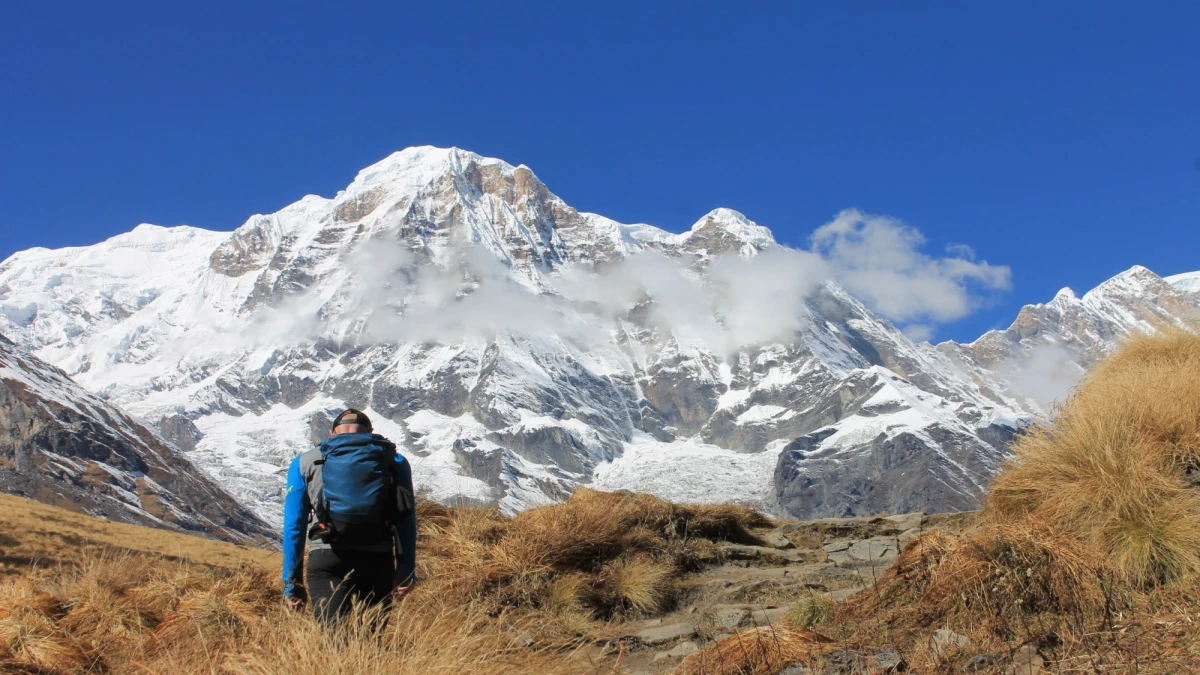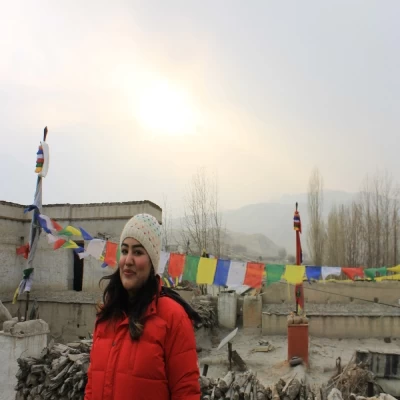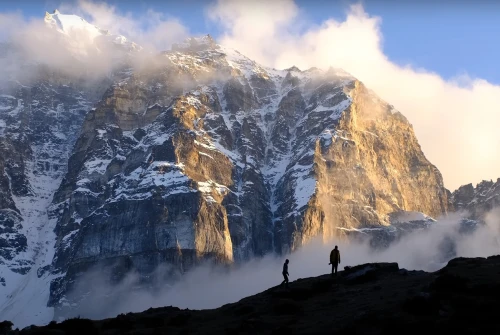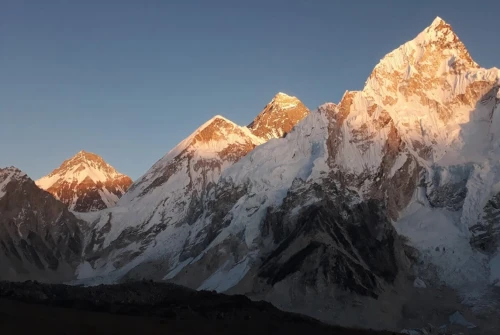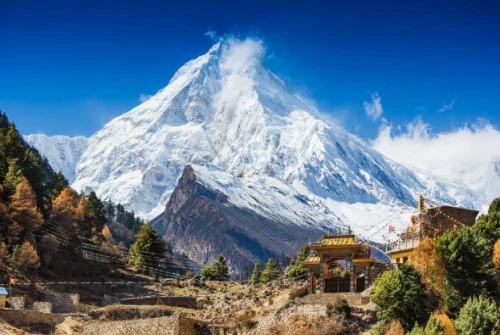Overview
The Annapurna Base Camp Trek stands as one of Nepal’s most iconic journeys, a perfect blend of adventure, culture, and breathtaking scenery. October, being the heart of Nepal’s autumn season, transforms this trek into a once-in-a-lifetime experience. The clear blue skies, crisp air, and golden hues of the forests create a postcard-perfect landscape at every turn.
What makes this trek unique is its accessibility and diversity. Within just a few days of hiking, trekkers pass through lush subtropical forests, terraced farmlands, and high alpine landscapes leading to the dramatic amphitheater of the Annapurna Sanctuary. Every sunrise and sunset paints the mountains, including Annapurna I (8,091m), Machapuchare (Fishtail, 6,993m), and Hiunchuli, in brilliant shades of gold and crimson.
Besides its natural beauty, the route offers a deep cultural immersion. The trail passes through charming Gurung and Magar villages, where locals greet you with warm smiles and stories of the Himalayas. In October, you also get to witness Nepal’s biggest festivals, Dashain and Tihar, which bring vibrant decorations, dances, and rituals to the villages.
For those seeking the perfect mix of adventure, comfort, and cultural exploration, October is undeniably the best month to experience the Annapurna Base Camp Trek.
Why October is the Best Month for the Annapurna Base Camp Trek
October is considered the peak trekking season in Nepal, and for good reason. The monsoon rains have just ended, leaving behind fresh air, blooming nature, and crystal-clear mountain views. The weather is neither too hot nor too cold, making it ideal for trekking across diverse elevations.
The trails are well-defined, teahouses are fully operational, and the hospitality of locals is at its peak. Whether you’re a first-time trekker or an experienced adventurer, October provides an optimal balance between comfort, challenge, and beauty.
Let’s explore why October holds such special significance for this Himalayan journey.
Ideal Weather and Temperature in October
During October, the weather along the Annapurna Base Camp Trek is at its most pleasant, dry, stable, and crystal clear. In the lower altitudes (around Pokhara – Nayapul – Ghandruk, 1,000m–2,000m), mornings are mild with temperatures between 10°C to 15°C, and the days warm up to a comfortable 18°C to 25°C, perfect for trekking in light layers.
As you move toward mid-altitude regions such as Chhomrong and Deurali (2,000m–3,200m), mornings become cooler, hovering around 5°C to 10°C, while daytime temperatures stay between 12°C and 20°C, offering refreshing walking conditions with minimal humidity.
At higher altitudes, especially around Machhapuchhre Base Camp and Annapurna Base Camp (3,700m–4,130m), the temperature drops significantly; mornings can dip to -3°C to 0°C, daytime highs average 5°C to 10°C, and nighttime temperatures can fall as low as -5°C to -8°C under clear skies.
Despite the chill, the visibility in October remains exceptional, offering breathtaking views of the snow-dusted peaks, glowing sunsets, and an overall ideal balance between comfort and adventure on the trail. The mornings are cool and refreshing, ideal for long treks, while afternoons are comfortably warm for enjoying tea breaks in the sun. The skies remain mostly clear, ensuring uninterrupted panoramic views of the Annapurna range throughout the journey.
Rainfall is minimal, trails are dry, and landslides or leech problems from the monsoon season are gone, all of which make October the most hassle-free month for trekking.
Perfect Visibility for Panoramic Views
If you dream of capturing the clearest and most photogenic views of the Himalayas, October is unbeatable. After the cleansing effect of the monsoon, the skies turn crystal clear, offering visibility that stretches for miles.
The sight of Annapurna South, Machapuchare, and Dhaulagiri gleaming under the bright blue sky is absolutely mesmerizing. Sunrise from Poon Hill and Machapuchare Base Camp is especially unforgettable during this month — the orange and pink glow illuminating snow-capped peaks makes every step worthwhile.
Trekkers often describe October as the time when “you can almost touch the mountains.”
Festivals and Cultural Celebrations During October
October is also the most festive month in Nepal, bringing an extra layer of cultural charm to your trekking experience. The two grandest festivals — Dashain and Tihar (Deepawali) — fall in this month.
Dashain, celebrated for 15 days, symbolizes the victory of good over evil. Villages are filled with laughter, kite-flying, and traditional rituals.
Tihar, also known as the festival of lights, sees homes decorated with oil lamps, marigolds, and colorful rangolis.
Trekking during these celebrations lets you witness the warmth, hospitality, and deep-rooted traditions of Nepalese people up close. Villagers often invite trekkers to join in the festivities, making October not just scenic — but soulfully enriching.
Scenic Beauty You Can Expect in October
Trekking to Annapurna Base Camp in October means immersing yourself in a landscape that feels alive — every corner bursts with color, texture, and breathtaking detail. The air is fresh, the trails are vibrant, and the environment feels renewed after the monsoon rains. This is the time when the Himalayas showcase their full splendor — crystal-clear skies, golden terraces, and snow-capped peaks shimmering under the autumn sun.
Autumn Colors and Landscapes
October is when the Annapurna region transforms into a painter’s paradise. As you start the trek from Nayapul, the lower hills are covered in lush greenery, while the forests at mid-altitudes (around Ghandruk and Chhomrong) turn into a mosaic of yellow, orange, and red hues. The terraced fields brim with ripe rice crops, and you can often see local farmers harvesting under the warm autumn sun.
The trails wind through rhododendron and oak forests that gently sway in the cool mountain breeze. Sunlight filters through the trees, creating a golden glow that gives the forest an almost magical appearance. The contrast of bright foliage against snow-draped peaks like Machapuchare and Annapurna South is something every trekker remembers for life.
October’s balance of warm days and clear skies means you’ll enjoy long, scenic walks without the fog or rain that sometimes obscures views in other months. Every rest stop becomes a viewpoint, and every step feels like walking through a living postcard.
Crystal Clear Mountain Views
October is known as the month of clarity in the Himalayas. The dust and haze of summer have settled, leaving behind skies that look like sheets of blue glass. The result is panoramic visibility that lets you see mountain ranges far beyond the Annapurna massif.
From early morning till dusk, trekkers are treated to unobstructed views of Annapurna I (8,091m), Annapurna South, Hiunchuli, Gangapurna, and the sacred Machapuchare (Fishtail Mountain). The mountains seem close enough to touch — especially from Machapuchare Base Camp (3,700m) and Annapurna Base Camp (4,130m), where a 360° wall of white peaks surrounds you.
The sunsets and sunrises in October are pure magic. The peaks turn shades of fiery orange and pink before fading into soft gold, moments that photographers and nature lovers cherish forever. Night skies are equally stunning, with stars shining brilliantly over the snow-covered summits, making October one of the best times for astro photography and peaceful stargazing.
Flora and Fauna Along the Trail
The Annapurna Conservation Area is a biodiversity hotspot, and October is one of the best times to experience its natural richness. The forests are full of chirping birds, fluttering butterflies, and blooming wildflowers left over from the post-monsoon season. You might spot colorful Himalayan monals (Nepal’s national bird), pheasants, and langurs jumping between the trees.
In the lower regions, the scent of blooming marigolds and freshly cut paddy fields fills the air, while higher up, you’ll see alpine meadows dotted with dwarf rhododendrons and junipers. The rivers and waterfalls that were swollen during the monsoon now flow clearly, adding to the peaceful soundtrack of your journey.
Trekking through this environment in October feels rejuvenating. The natural world is calm yet full of life, and the harmony between the terrain, people, and wildlife gives this trek a deeply grounding and meditative quality.
Trek Difficulty and Trail Conditions in October
The Annapurna Base Camp Trek in October offers the best possible balance between trail safety and adventure. The weather is steady, the paths are well-defined, and there’s minimal risk of rain or snow, making it an excellent choice even for beginners with moderate fitness.
Unlike the wet monsoon or freezing winter months, October allows you to enjoy each step without worrying about slippery mud or extreme cold. It’s the month when both novice trekkers and seasoned hikers can experience the Himalayas in their purest form, calm, colorful, and clear.
How the Weather Affects Trail Difficulty
In October, the weather is your best friend. The trails are dry, and the risk of landslides or leeches is almost zero. The moderate temperature means you won’t overheat while climbing uphill or shiver during early morning hikes. This comfortable climate helps trekkers maintain good stamina and minimizes fatigue.
The lower sections of the trek, such as Tikhedhunga or Ghorepani, are pleasant and green, while the higher stretches beyond Deurali are crisp and cool. Snow rarely blocks the paths, and visibility is perfect — which greatly improves navigation and safety.
Even though the trail sees more trekkers in October, the routes are well-marked and regularly maintained by locals and guides. You’ll find rest stops, tea houses, and information signs at most intervals, ensuring a smooth and safe journey from start to finish.
Tips for Trekking Safely in October
Even though October is one of the safest months for trekking, preparation remains key to enjoying the journey comfortably. Here are some essential safety tips:
- Start Early: Begin your trek each morning around 7 AM to avoid afternoon clouds or light winds.
- Stay Hydrated: The crisp air can dehydrate you quickly, so drink plenty of water.
- Use Trekking Poles: They help reduce pressure on knees during descents, especially on stone steps.
- Wear Proper Layers: Morning and evening temperatures can drop sharply; dress in layers you can easily adjust.
- Acclimatize Gradually: Spend time at Machapuchare Base Camp before heading to ABC to prevent altitude sickness.
- Carry a Headlamp: October evenings get darker early; having a light source ensures safe navigation after sunset.
By following these simple precautions, trekkers can experience the Himalayas to their fullest — safely, comfortably, and confidently.
Accommodation and Food During the Trek
One of the highlights of the Annapurna Base Camp Trek in October is the comfort and hospitality trekkers experience along the trail. October being peak season, all teahouses, guesthouses, and lodges are open and well-stocked. From cozy mountain lodges with warm fireplaces to freshly cooked Nepali meals made with love, the food and accommodation on this trek greatly enhance the overall Himalayan experience.
Trekkers not only get a good night’s sleep in clean rooms but also get to taste local delicacies and share stories with fellow adventurers and local hosts — creating beautiful memories along the journey.
What Type of Lodges and Tea Houses You’ll Find
The Annapurna Base Camp trail is known for its well-developed network of tea houses and guesthouses that cater to trekkers of all budgets. Most lodges are family-run, offering warm hospitality that reflects the kindness of the Himalayan people.
In the lower regions (such as Ghandruk, Chhomrong, and Bamboo), you’ll find comfortable rooms with attached bathrooms, electricity, and sometimes even Wi-Fi. As you go higher (toward Deurali, Machapuchare Base Camp, and Annapurna Base Camp), the facilities become simpler but still clean and cozy. Expect twin-sharing wooden rooms with clean blankets, pillows, and shared bathrooms.
Many teahouses also have dining halls with wood-burning stoves, where trekkers gather in the evenings to eat, warm up, and socialize. The atmosphere is friendly and communal, with trekkers exchanging travel stories while sipping cups of hot ginger tea.
Since October is the busiest month, it’s advisable to book your accommodation in advance, especially in popular stops like Ghorepani and Chhomrong, to secure the best lodges and rooms.
Meals and Local Delicacies to Try
Food during the trek is hearty, comforting, and freshly prepared, perfect for fueling your journey through the Himalayas. Most tea houses offer a wide menu that blends Nepali, Tibetan, and international cuisines, ensuring you have plenty of variety throughout the trek.
The classic Nepali dish Dal Bhat Tarkari, a combination of rice, lentil soup, and vegetable curry, is the most popular and nutritious meal. It’s served with pickles and sometimes meat options like chicken or buff (buffalo), depending on the region. The best part? You can always ask for refills, making it the ultimate energy booster for trekkers.
Other delicious options include:
- Momos (dumplings): Steamed or fried, filled with vegetables or meat.
- Thukpa: A Tibetan noodle soup that’s warm and filling, especially at higher altitudes.
- Apple pie and pancakes: Found in most lodges, often baked fresh with local apples.
- Hot drinks: Tea, coffee, hot lemon with honey, and masala chai are available everywhere and help keep you hydrated and warm.
During October, since the weather is mild and food supplies are abundant, the quality and freshness of meals are at their best. You’ll also see villagers drying corn, chillies, and herbs outside their homes, a picturesque reminder of Himalayan life and self-sustainability.
How Busy Are the Lodges in October?
October is the busiest trekking month in Nepal, which means you’ll encounter a vibrant and social atmosphere along the trail. While this adds energy to the journey, it also means that accommodations fill up quickly, especially in places like Deurali or Machapuchare Base Camp.
To avoid any inconvenience:
- Book your lodges a day ahead whenever possible.
- Start your trek early to reach your next stop before the crowds.
- Consider traveling with a registered guide or agency that can handle bookings for you.
Despite the high number of trekkers, most teahouses manage efficiently. The staff are experienced in handling large groups, and meals are served quickly. If you enjoy meeting people from around the world, exchanging travel tips, learning about local traditions, or sharing laughter over dinner, October offers an incredibly sociable experience that few other months can match.
Traditions, People, and Culture Along the Route
What truly makes the Annapurna Base Camp Trek special goes beyond the mountains; it’s the people who live in their shadows. The trail passes through villages rich in Gurung, Magar, and Thakali culture, each with its own traditions, dialects, and lifestyles. October, being the festive season in Nepal, is when these villages come alive with color, music, and celebration.
Trekking during this month gives you an authentic window into Himalayan life, how locals farm, celebrate, and preserve their culture in the face of modernization. The hospitality you’ll encounter will warm your heart as much as the mountain sun.
Gurung and Magar Communities
The majority of people you’ll meet on the Annapurna trail belong to the Gurung and Magar ethnic groups. These communities are known for their bravery (many serving in the British and Indian Gurkha regiments) and their gentle, welcoming nature.
The Gurung villages of Ghandruk and Chhomrong are cultural highlights of the trek. Here, you’ll find traditional stone houses with slate roofs, women dressed in beautiful patterned aprons, and prayer flags fluttering in the wind. Many homes have small shrines, and you may hear the rhythmic chanting of Buddhist prayers in the evenings.
Locals are always eager to share stories about mountain spirits, past expeditions, and their daily lives. They take immense pride in their heritage, and spending an evening in these villages, perhaps enjoying local millet beer (known as tongba or raksi), offers a glimpse into their joyful and resilient way of life.
Religion and Cultural Practices
Religion is deeply woven into the daily life of the Annapurna region. You’ll see both Hindu and Buddhist influences along the trail, sometimes blending harmoniously in the same village. Prayer wheels, chortens (Buddhist shrines), and mani walls inscribed with sacred mantras are common sights.
In October, temples and monasteries are beautifully decorated for Dashain and Tihar, with villagers making offerings, hanging marigold garlands, and lighting oil lamps at dusk. During your stay, you might witness rituals where elders bless children, animals, and even travelers passing through, a gesture symbolizing protection and goodwill.
Such moments reveal the spiritual heart of the Himalayas, reminding trekkers that this region is not just about nature’s grandeur but also about the deep faith and harmony that sustain life in these remote valleys.
Hospitality and Lifestyle in the Himalayas
Hospitality in the Himalayas goes far beyond service; it’s part of the local identity. No matter where you stop, you’ll be greeted with warm smiles, a “Namaste,” and often a hot cup of tea. The mountain people are humble, hardworking, and genuinely kind, always ready to assist trekkers who pass through their villages.
The simplicity of their lifestyle, cooking over wood fires, tending fields, and sharing communal meals, stands in contrast to the modern world but offers lessons in contentment and balance. Many trekkers say that the warmth of these people stays with them long after the trek ends.
October enhances this connection, as villagers are more relaxed after the harvest season and open to sharing their stories, music, and traditions. It’s the perfect month to truly connect with both nature and humanity in one journey.
Packing List for the Annapurna Base Camp Trek in October
Packing wisely for the Annapurna Base Camp Trek in October is crucial for ensuring comfort, warmth, and safety throughout your journey. October offers pleasant weather during the day and chilly nights at higher altitudes. As this is one of the most beautiful yet busy trekking months, you’ll want to be well-prepared with layered clothing, proper gear, and essential accessories to handle varying temperatures and trail conditions.
A well-organized packing list ensures you can trek confidently, light enough to enjoy the journey, but equipped enough to face any weather changes the Himalayas might surprise you with.
Essential Trekking Gear
Your trekking gear should prioritize durability, comfort, and weight efficiency. The Annapurna Base Camp route varies from humid forests to icy alpine regions, so having the right equipment is key.
Here’s a list of must-have gear for October trekkers:
- Backpack (40–50L): Lightweight with good back support and rain cover.
- Daypack (20L): For carrying daily essentials like snacks, water, a camera, and layers.
- Sleeping Bag: Rated for at least -10°C. Even though tea houses provide blankets, nights at ABC can get freezing.
- Trekking Poles: Useful for stability on rocky and steep descents.
- Water Bottles or Hydration Bladder: At least 2 liters capacity. Refill from lodges using filtered or boiled water.
- Headlamp: Essential for early morning treks or nighttime use.
- Sunglasses and Sunscreen: The sun’s UV rays are stronger at higher altitudes.
- Reusable Cutlery and Cup: Promotes eco-friendly trekking by reducing plastic waste.
- Camera or Smartphone: To capture the stunning beauty of the Annapurna Sanctuary.
If you’re renting gear in Pokhara, make sure it’s in good condition and fits comfortably. Most trekking shops there provide high-quality equipment at affordable prices.
Layering Clothes for Autumn Conditions
October weather can change quickly, warm under the sun and cold in the shadows, so layering is the best strategy. It allows you to adjust your clothing easily as temperatures shift throughout the day.
Here’s the recommended layering system for your trek:
Base Layer (Inner Layer)
- Moisture-wicking T-shirts (synthetic or merino wool)
- Thermal tops and bottoms for nights at higher altitudes
Mid Layer (Insulation Layer)
- Fleece jacket or lightweight down jacket for warmth
- Soft-shell jacket for moderate wind protection
Outer Layer (Shell Layer)
- Waterproof and windproof jacket (Gore-Tex or similar material)
- Waterproof trekking pants for unexpected drizzles
Lower Body and Feet
- Convertible trekking pants for flexibility
- Thermal leggings for colder evenings
- Wool or synthetic hiking socks (at least 3–4 pairs)
- Quality hiking boots (well broken-in)
- Lightweight sandals or slippers for tea house use
Head and Hands
- Sun hat or cap for daytime
- Warm beanie and buff for evenings
- Lightweight gloves (fleece or wool)
The goal is to be ready for both warm days (around 20°C) and cold nights (down to -2°C). Dressing in layers keeps you comfortable and reduces the need to carry bulky items.
Must-Have Accessories and Gadgets
Small accessories can make a big difference in your comfort and safety on the trail. Here’s what you shouldn’t forget:
- Trekking Towel: Quick-drying microfiber towel is best for tea house use.
- Toiletries: Biodegradable soap, toothbrush, toothpaste, hand sanitizer, and wet wipes.
- Portable Power Bank: Tea houses may charge extra for electricity, so having a reliable power source helps.
- First Aid Kit: Include band-aids, blister pads, pain relievers, altitude sickness medicine (Diamox), and any personal medication.
- Snacks: Protein bars, chocolate, nuts, and electrolytes are great for energy on long climbs.
- Travel Insurance Documents: Make sure it covers trekking above 4,000 meters.
- Maps and Permits: Always carry photocopies of your TIMS and ACAP permits.
A well-packed backpack should weigh between 8–12 kg, excluding water. Keeping your load light but complete ensures you can enjoy each step of the trek without unnecessary strain.
Health and Safety Tips for Trekking in October
Trekking to Annapurna Base Camp in October is safe and enjoyable if you follow basic health and safety guidelines. Even though this month has the most stable weather, the altitude and terrain still require caution, awareness, and preparedness. Proper acclimatization, hydration, and self-care will help you make the most of your Himalayan adventure.
Acclimatization and Altitude Sickness
Altitude sickness, or AMS (Acute Mountain Sickness), can affect anyone above 2,500 meters — even fit trekkers. Symptoms include headaches, dizziness, fatigue, and loss of appetite. The key to avoiding AMS is gradual acclimatization.
Here’s how to stay safe:
- Ascend slowly: Don’t rush; take regular breaks during climbs.
- Hydrate well: Drink at least 3–4 liters of water per day.
- Avoid alcohol and smoking: Both reduce oxygen absorption.
- Sleep at lower altitudes if possible: Descend if symptoms worsen.
- Consider Diamox: Consult your doctor before the trek about taking preventive medication.
The itinerary for the ABC trek naturally allows gradual ascent, giving your body time to adjust. Spending a night at Machapuchare Base Camp (3,700m) before heading to Annapurna Base Camp (4,130m) is a smart choice for acclimatization.
First Aid and Emergency Plans
Even in October’s mild weather, minor injuries or health issues can happen. Carry a small first aid kit with antiseptics, bandages, and medicines for headaches or stomach issues. Always keep your guide or trekking partner informed if you feel unwell.
In case of serious emergencies:
- Helicopter evacuation is available from ABC or nearby villages, but ensure your travel insurance covers it.
- Local health posts in Chhomrong or Ghandruk provide basic treatment for mild conditions.
- Guides and porters are trained to recognize early signs of altitude sickness and dehydration, so follow their advice.
October’s clear skies make rescue operations faster if ever needed, one more reason it’s the safest month for trekking.
Conclusion
In conclusion, the Annapurna Base Camp Trek in October offers a perfect blend of adventure, breathtaking mountain views, cultural immersion, and comfortable trekking conditions. From crisp mornings and sunny days to starry Himalayan nights, every moment of this trek is memorable. Along the way, you’ll experience warm hospitality, savor authentic Nepali cuisine, and witness the vibrant traditions of the Gurung and Magar communities. At All Nepal Hiking, we are dedicated to making your journey safe, seamless, and truly unforgettable. Let us guide you through this once-in-a-lifetime adventure to the heart of the Annapurna Sanctuary, creating memories that will last forever.
